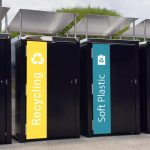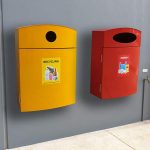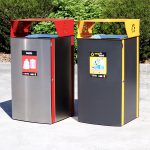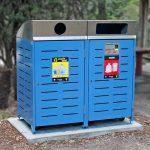
Waste separation at the source is the key to cleaner, more efficient recycling of waste resources.
China was a major destination for most of our waste up until early 2018 where they banned the import of many types of waste including plastics and paper. Australia was suddenly faced with no immediate option on where to send recyclable materials, and it led to more waste going to landfill.
In response to this crisis, the Australian governments all worked together to update the National Waste Policy, endorsing the shift to a circular economy. By 2019 an action plan was formed with targets such as:
- A ban on the export of waste plastic, paper, glass and tyres, commencing in the second half of 2020
- An 80 per cent average recovery rate from all waste streams by 2030
- Significantly increasing the use of recycled content by governments and industry
- Making comprehensive, economy-wide and timely data publicly available to support better consumer, investment and policy decisions
- Halving the amount of organic waste sent to landfill by 2030 and
- Phasing out problematic and unnecessary plastics by 2025.
2021 sees Australia pushing towards and achieving these goals, and a greener future.
What is a circular economy?
It’s about changing the way we design, produce, make, sell and use products to minimise waste, the use of energy in their production, demand for virgin materials, landfill, and our impact on the environment. The aim is to keep materials and resources in use by making products with recyclable and reusable materials. Also for a variety of goods that must meet a product standard that enables the goods to be easily refurbished. Materials are recovered, recycled and re-manufactured, rather than disposed of in landfill.

While many of our standard consumer practices will need to be changed to make way for a circular economy, the diagram above illustrates that the disposal stage – critical to a circular economy – needs to be streamlined. Waste separation. A fundamental point that can stop the waste from ending up in landfill. We can all help at this point, but it all hinges on how we dispose of our waste.
Separate waste streams
 Up till now, we have been familiar with separating our glass, some of our plastic and our paper and cardboard, but this is set to change. For instance, Victorian households are set to adopt a new four (4) bin roadside system: Landfill, recycling, glass and food organics/garden organics (FOGO) waste streams. Other states and councils have also bolstered their waste programs in order to recover their waste streams more efficiently too. As more recycling infrastructure becomes available these options will change to suit.
Up till now, we have been familiar with separating our glass, some of our plastic and our paper and cardboard, but this is set to change. For instance, Victorian households are set to adopt a new four (4) bin roadside system: Landfill, recycling, glass and food organics/garden organics (FOGO) waste streams. Other states and councils have also bolstered their waste programs in order to recover their waste streams more efficiently too. As more recycling infrastructure becomes available these options will change to suit.
Other waste stream channels
 Many major and minor retail chains have switched on to circular economy thinking making them more responsible for their waste and also providing drop off points for customers to discard old and broken products and consumables.
Many major and minor retail chains have switched on to circular economy thinking making them more responsible for their waste and also providing drop off points for customers to discard old and broken products and consumables.
Officeworks for instance, has a great community and sustainability program, giving back to the community while responsibly dealing with the e-waste associated with their industry.
 Redcycle from Redgroup has teamed with Coles and Woolworths to take back all soft plastics from packaging and bags, keeping these dangerous materials away from our waterways and converting them to usable products like park seats.
Redcycle from Redgroup has teamed with Coles and Woolworths to take back all soft plastics from packaging and bags, keeping these dangerous materials away from our waterways and converting them to usable products like park seats.
Opportunity shops are the best way to dispose of unwanted clothes and homewares. You will find these in almost every town across Australia. Whether large or small, these are charitable organisations that give back to the community.
There are many more recycling groups that can direct you to the appropriate place to dispose of almost anything responsibly. The more we do this the less that ends up in landfill, the ultimate goal for a circular economy.
ASPIRE – Empowering businesses to exchange waste as a resource
Public waste separation
 While we can easily control what waste goes in what bin at home and in the workplace, public waste bins are problematic mostly due to the lack of conveniently placed and clearly marked bins. Policies have been clearly set for waste separation at households and initiatives put forward to help business work towards the circular economy, but it seems that public waste bin strategies are left up to each council. Some have had public recycling bins alongside their general waste bins for some time, and can easily add extra waste stream bins to these sites. While others who wish to pursue further separated waste streams may need to overhaul their public waste systems, and some councils would be in the process of doing so currently.
While we can easily control what waste goes in what bin at home and in the workplace, public waste bins are problematic mostly due to the lack of conveniently placed and clearly marked bins. Policies have been clearly set for waste separation at households and initiatives put forward to help business work towards the circular economy, but it seems that public waste bin strategies are left up to each council. Some have had public recycling bins alongside their general waste bins for some time, and can easily add extra waste stream bins to these sites. While others who wish to pursue further separated waste streams may need to overhaul their public waste systems, and some councils would be in the process of doing so currently.
So then what waste stream bins can be placed publicly to provide the best coverage and efficiency for councils? The best solution is all of them:
- Landfill – for all rubbish that cannot be classified into the other three groups
- Recycling – Paper, Cardboard, Plastic and Metal containers
- Glass – Bottles, Jars and other Glass Containers
- FOGO – Food Organics and Garden Organics
Is public FOGO a no go?
From most initial reports it seems household FOGO bins have minimal contamination from other waste types. The apprehension in moving forward with this public waste stream comes from:
- wondering if the waste will be contaminated by too many other waste types being placed in the bins
- vermin and other pests capitalising on the food scraps
- the odour from this particular waste stream compared to others
 We have observed that some councils have commenced trials for public placed FOGO bins. Most have started their trials in appropriate locations such as popular public picnic and barbeque areas. Now, with the move away from single use plastics, the chance of contamination is further limited. Paper plates with food scraps and paper straws and cardboard can be placed in FOGO bins without fear of contamination. These items will be processed along with the organic waste.
We have observed that some councils have commenced trials for public placed FOGO bins. Most have started their trials in appropriate locations such as popular public picnic and barbeque areas. Now, with the move away from single use plastics, the chance of contamination is further limited. Paper plates with food scraps and paper straws and cardboard can be placed in FOGO bins without fear of contamination. These items will be processed along with the organic waste.
These trials are to prove organic waste is no more at threat to vermin and pests than normal rubbish bins. Regular servicing of all bins will reduce this problem, and will control the odour from the bins also.
It would seem that FOGO bins would work in public places. Appropriate sites in particular would benefit from this extra bin, and it would become second nature to the public to use these bins as we move forward into a circular economy.
Trialling a new waste stream?
Draffin Street Furniture would love to hear from any council or organisation regarding their waste separation efforts. A circular economy is one that benefits all in many ways, and shared knowledge helps us get there quicker! How did your public placed FOGO trial work? What was the outcome? Do you have a special waste stream collection point, and how and where is it processed? How did the public respond to your introduced collection point?
Big or small project, successful or failed trials, these efforts should not go unnoticed.
Collectively we can move faster toward a cleaner future.
Clear identification for public bins
To standardise identification for waste types it seems some councils are taking the same colour scheme as the 4 bin system similarly about to be used in Victoria. While all councils have their own colour system currently, it would only make sense to standardise this nationally to reduce confusion. Since there is a large movement nationally towards waste separation changes, now is the time to move to a national standard.
- Red – Landfill
- Yellow – Recycling
- Purple – Glass
- Green – Fogo
Clear logos would also help. Many councils who are utilising a multi bin recycling scheme have also used information based decals and signage to educate the public on the waste types each bin accepts. This is also a great opportunity to inform the public on what councils are doing on the “War on Waste” front!

Signage for bin surrounds
 A standard signage guide has been compiled, comprising the most common decals and signage used on bin surrounds. You can find the guide on all bin related product pages, or simply download the guide here to the right. ►
A standard signage guide has been compiled, comprising the most common decals and signage used on bin surrounds. You can find the guide on all bin related product pages, or simply download the guide here to the right. ►
Draffin has always prided itself on custom products. And custom signage is just the start. Whatever your signage needs for any waste type, Draffin Street Furniture can cater for. Choose from the large range of bin surround styles we offer, submit a quote request or contact us to sort out the finer details for your requirements.
- Internal Bin
- 800 Series
- Infinity Series
- Custom
- Custom
- Custom
- 1500 Series
- 1500 Series
- Infinity Series
- Custom
- 1500 Series
- Bin Corral
- Double Bay Arena Series
- Infinity Series
- Infinity Series
- Wall Mount Bins
- Infinity Series
- 800 Series
- Infinity Series
- 1500 Series
- 1500 Series
- Yarra Bins
- 1200 series
- 800 Series
- 800 Series
- 1200 Series
- Infinity Series
- Infinity Series





























